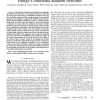Free Online Productivity Tools
i2Speak
i2Symbol
i2OCR
iTex2Img
iWeb2Print
iWeb2Shot
i2Type
iPdf2Split
iPdf2Merge
i2Bopomofo
i2Arabic
i2Style
i2Image
i2PDF
iLatex2Rtf
Sci2ools
TSP
2008
2008
Optimal Node Density for Detection in Energy-Constrained Random Networks
The problem of optimal node density maximizing the Neyman-Pearson detection error exponent subject to a constraint on average (per node) energy consumption is analyzed. The spatial correlation among the sensor measurements is incorporated through a Gauss-Markov random field (GMRF) model with Euclidean nearest-neighbor dependency graph. A constant density deployment of sensors under the uniform or Poisson distribution is assumed. It is shown that the optimal node density crucially depends on the ratio between the measurement variances under the two hypotheses and displays a threshold behavior. Below the threshold value of the variance ratio, the optimal node density tends to infinity under any feasible average energy constraint. On the other hand, when the variance ratio is above the threshold, the optimal node density is the minimum value at which it is feasible to process and deliver the likelihood ratio (sufficient statistic) of the sensor measurements to the fusion center. In this r...
Related Content
| Added | 16 Dec 2010 |
| Updated | 16 Dec 2010 |
| Type | Journal |
| Year | 2008 |
| Where | TSP |
| Authors | Animashree Anandkumar, Lang Tong, Ananthram Swami |
Comments (0)

